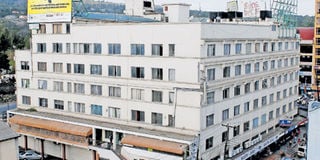Investors in Nakuru opt for flats to maximise resources

The town’s population has grown rapidly in the past few years, leading to an acute housing shortage, with high demand among students and the newly employed. PHOTO| FILE| NATION MEDIA GROUP
What you need to know:
Initially, investors constructed mainly commercial blocks in the town’s central business district, but some of the residential houses that have been put up in the last two years are apartments.
However, real estate investors in the town, especially in residential housing, are also turning to bedsitters to meet the rising demand for housing linked to the high number of students studying in various institutions of higher learning that have established branches in the town.
The high demand for commercial premises and residential houses in Nakuru has seen investors rush to cash in, triggering rapid changes in the town’s skyline in the last five years.
High-rise buildings and apartment blocks are replacing bungalows in many parts of the town, with areas that once served as grazing fields giving way to real estate development.
From affluent neighbourhoods like Milimani, Naka, Section 58, Kiamunyi to modest areas like Langa Langa, Mwariki and WhiteHouse, Nakuru’s real estate dynamics have changed.
The latest, and tallest high-rise building in the town, Tower 1, is coming up on the town’s main street, Kenyatta Avenue.
It is expected to transform Nakuru’s skyline, with its futuristic look providing spectacular views of the town and the famous Lake Nakuru.
The 14-storey Tower 1 boasts three basement parking levels and 11 floors of rental space for commercial purposes.
“The ground floor is expected to host banks and the first floor an eatery. We also intend to make the 10 floor an executive one with a panoramic view of the town, enfolded with frameless glass and a surrounding balcony,” said Mr James Ngugi, a consultant working on the project.
For more than five years, CK Patel building has been the tallest building in Nakuru, towering over other high-rise structures like Ereto Plaza and Gatehouse.
Initially, investors constructed mainly commercial blocks in the town’s central business district, but some of the residential houses that have been put up in the last two years are apartments.
However, real estate investors in the town, especially in residential housing, are also turning to bedsitters to meet the rising demand for housing linked to the high number of students studying in various institutions of higher learning that have established branches in the town.
The single rooms that function as kitchen, living room and bedroom, with an adjoining toilet and bathroom are popular among college students and newly employed young people.
Mr Andrew Chege, the director of Point A Commercial Agencies, says that since Nakuru is a tourism and economic hub, learning institutions, big companies and industries have set up shop in the Rift Valley town, leading to a high population growth and hence the housing shortage, as well as a sharp increase in rent as the demand for decent housing continues to rise.
“Initially, Nakuru had old bungalows which have since been replaced with modern flats and high-rise buildings. In a span of five years, so much has changed,” says Mr Chege, adding that the future of the real estate industry in Nakuru is bright.
Banks and other financial institutions have also not been left behind as they open branches in the town in a rush to cash in on the opportunity with loans and other credit facilities for real estate development.
Moses Kimani, a local contractor, says that the rising cost of land, which now has hit the Sh100 million mark in the town’s CBD, investors in housing want to maximise on their resources, hence preference for flats and high-rise buildings.
While it is architecturally harder to construct flats, he explains, the capital input is cheaper and the profits substantially more for the owners.
“There is a huge demand for houses in Nakuru, so contractors are cutting down construction costs without compromising on quality and standards,” notes Mr Kimani.
Experts say Nakuru, like Narok and Nyandarua, has witnessed an influx of investors from Nairobi who have been driven out by escalating land prices in the city.
The instability experienced here following the post-election volence in 2007 scared away investors in the real estate industry, but investment picked up again in 2009 and has remained vibrant.





